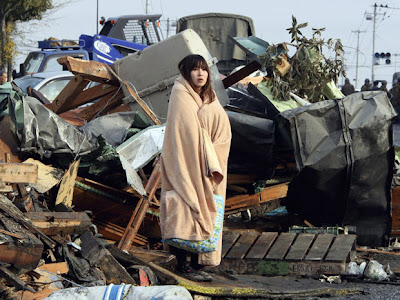after the quakes

This column was supposed to be about recent upheavals in the manga industry that have permanently rearranged the publishing landscape in Japan and overseas. A few weeks ago, Kodansha, Japan’s largest publisher and owner of licenses for Akira, Ghost in the Shell and other internationally renowned anime titles, purchased New York-based Vertical, Inc., the decade-old indie publisher of Japan-related literature, manga and nonfiction works, in a joint acquisition with Dai Nippon Printing.
Vertical has become especially notable for producing elegant paperback editions of lesser known titles by Osamu Tezuka, the father of modern manga and anime, such as Ayako and Ode to Kirihito, in addition to his popular Black Jack series. Given that Kodansha ended its licensing agreement with Del Rey Manga late last year, its Vertical buyout is seen as another step the company’s move toward more ‘hands-on’ management of the US manga market.
But the company wasn’t finished. One week after its purchase of Vertical, Kodansha suddenly announced that next month would see the end of its 48 year-old English-language imprint, Kodansha International—a move that was apparently unexpected by the imprint’s authors and, by some accounts, its own staff and editors. Kodansha International has translated and published numerous works of Japanese literature and nonfiction, including elaborately illustrated guides to Japanese baths and sake. It has also become a crucial purveyor of books delineating Japanese popular culture to non-Japanese fans, scholars and general readers.
In 1963, Kodansha International published the seminal Manga! Manga!: The World of Japanese Comics, Frederik L. Schodt’s capacious introduction to the history, artists and aesthetics of the uniquely Japanese form of art and entertainment. The book is now a consecrated classic—and remains invaluable to this writer. Recent years have seen a spate of richly illustrated, pocket-sized paperbacks from Kodansha International devoted to Japan’s pop culture niches, such as Shoko Ueda and Brian Aschcraft’s Japanese Schoolgirl Confidential, Patrick W. Galbraith’s The Otaku Encyclopedia, and Hiroko Yoda and Matt Alt’s Ninja Attack! and Yokai Attack! guidebooks. The lavishly designed hardcover editions of Plastic Culture by Woodrow Phoenix and Loving the Machine by Tim Hornyak are equally useful for non-Japanese readers keen for a broader understanding of the nation’s unique approach to the worlds of toys and robots, respectively.
Kodansha says it will focus instead on its North American operations via its regional presences, Kodansha USA and the newly acquired Vertical, Inc. Meanwhile, as of this writing, the fate of the above titles remains precarious.
This column was also supposed to be about the clash of wills taking place in Japan next weekend, March 26 and 27, when Tokyo Governor Shintaro Ishihara’s Tokyo International Anime Fair (TAF) will take place simultaneously with its new competitor—the Anime Contents Expo (ACE), launched by major anime and manga companies to protest the recently passed bill 156, seen by many as a crude stab at censorship. Overseas professionals trekking to Tokyo for the weekend tell me they will either boycot TAF in solidarity with the artists or frantically shuttle between TAF in Odaiba and ACE in Chiba to report on both.
I probably don’t need to explain to you what this column is really about, but I can’t help it. As I write, the TV images in my Oregon hotel room are relentless: the quake, the wave, the fires; the smoke, debris and bodies. The power plants.
This is about the evening of March 10, after I gave two talks on Japan’s popular and contemporary culture to students, faculty and others at the University of Oregon. A voice message was recorded on my mobile phone that evening during dinner with my hosts—a message I wouldn’t hear until much later, since work, wine and jet lag had effectively rendered me numb. The call was made during the afternoon of March 11, Japan-time, and it was from Tokyo. And the unsteady voice, barely recognizable and almost inaudible at times, described a swaying building, books and kitchen utensils strewn across the floor, a broken lamp and a broken clock.
“But I’m alive,” it concluded, trembling. “I’m still here.”

.jpg)